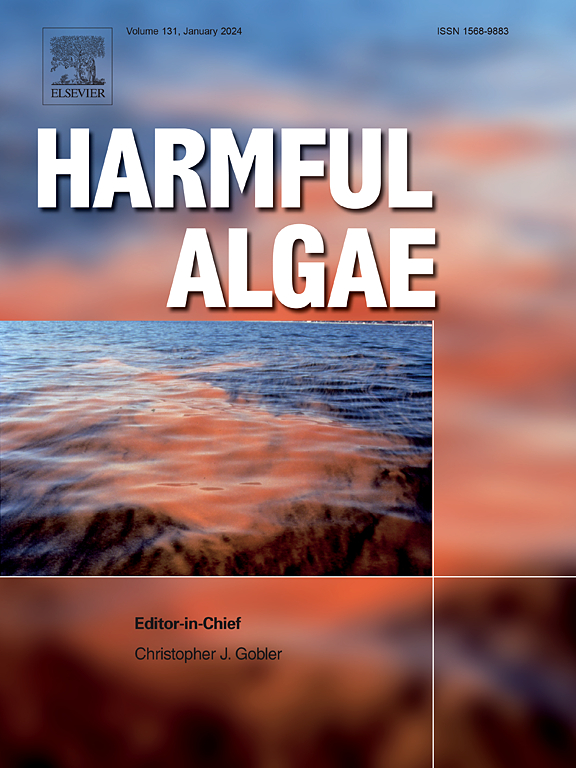亚丁湾(吉布提)和加利福尼亚湾(墨西哥)Lingulaulax djiboutiensis sp. 11 .的形态、分子、毒理学和生态学特征
IF 4.5
1区 生物学
Q1 MARINE & FRESHWATER BIOLOGY
引用次数: 0
摘要
吉布提位于红海和阿拉伯海交界处的塔joura湾(GT),作为研究吉布提沿海水域潜在有毒鞭毛藻多样性的勘探计划的一部分,发现了Lingulaulax属(以前称为Lingulodinium)的一个新物种。该新种命名为Lingulaulax djiboutiensis sp. nov.,得到了形态学和分子数据的支持。板公式,APC (Po, X, cp), 3ʹ,3 * 6ʹʹ,6 c, 6 s, 6ʹʹʹʹ,2ʹʹʹʹʹʹ,是Lingulaulax属的特征。在形态上,吉布提松子与聚聚松子的区别在于:(1)吉布提松子的个体(L: 34.8±1.9 μm, W: 34.7±1.9 μm, L:W比1.06±0.9)比聚聚松子的个体略小,压缩性更强;(ii)在L. djiboutiensis sp. nov.中,板1a与顶孔复合物(APC)接触;(3)吉布提草(L. djiboutiensis sp. nov.)的带骨(2.4 ~ 3.9µm)比聚德拉草(L. polyedra)的带骨(1.8 ~ 2.8µm)宽;(4)吉布氏滴虫毛囊孔直径(0.55 ~ 1.05µm)小于聚醚滴虫毛囊孔直径(0.94 ~ 1.33µm)。基于LSU和ITS核糖体DNA序列的系统发育分析表明,L. djiboutiensis sp. nov.属于L. polyedra的一个独立分支,与L. djiboutiensis sp. nov.有较高的自举值和贝叶斯推断(BI = 1.00, ML = 100)。来自加利福尼亚湾(墨西哥)和亚丁湾(GA)的两株L. djiboutiensis的种内进化差异非常低,在LSU地区为0%,在ITS地区为0.03%。相比之下,L. djiboutiensis和L. polyedra之间的进化差异更为明显,LSU区域为0.05%,ITS区域为0.15%,从而突出了这两个物种之间显著的系统发育分离。LC-MS/MS分析结果表明,枸杞无毒。此外,青藏高原的时空研究表明,该物种全年都存在,在夏末达到高峰。本文章由计算机程序翻译,如有差异,请以英文原文为准。
Morphological, molecular, toxicological, and ecological characterization of Lingulaulax djiboutiensis sp. nov. from the Gulf of Aden (Djibouti) and the Gulf of California (Mexico)
As part of an exploration program aimed at studying the diversity of potentially toxic dinoflagellates in the coastal waters of Djibouti, located in the Gulf of Tadjoura (GT) at the junction between the Red Sea and the Arabian Sea, a new species of the genus Lingulaulax (formerly known as Lingulodinium) was identified. This new species, designated Lingulaulax djiboutiensis sp. nov., is supported by morphological and molecular data. The plate formula, APC (Po, X, cp), 3ʹ, 3a*, 6ʹʹ, 6c, 6 s, 6ʹʹʹʹ, 2ʹʹʹʹʹʹ, is characteristic of the genus Lingulaulax. L. djiboutiensis sp. nov. can be distinguished morphologically from L. polyedra: (i) individuals of L. djiboutiensis sp. nov. (L: 34.8 ± 1.9 μm, W: 34.7 ± 1.9 μm, L:W ratio of 1.06 ± 0.9) are slightly smaller and more compressed than those of L. polyedra; (ii) in L. djiboutiensis sp. nov., plate 1a contacts the apical pore complex (APC); (iii) the cingulum of L. djiboutiensis sp. nov. (ranging from 2.4 to 3.9 µm) is wider than that of L. polyedra (ranging from 1.8 to 2.8 µm); and (iv) the diameter of the trichocyst pores of L. djiboutiensis sp. nov. (ranging from 0.55 to 1.05 µm) is smaller than that observed in L. polyedra (ranging from 0.94 to 1.33 µm). Phylogenetic analyses based on LSU and ITS ribosomal DNA sequences revealed that L. djiboutiensis sp. nov., belongs to a distinct clade, sister to and separate from L. polyedra, supported by high bootstrap values and Bayesian inferences (BI = 1.00 and ML = 100). The intra-species evolutionary divergence between the two strains of L. djiboutiensis from the Gulf of California (Mexico) and the Gulf of Aden (GA) is remarkably low, with a rate of 0 % in the LSU region and 0.03 % in the ITS region. In contrast, the evolutionary divergence between L. djiboutiensis and L. polyedra is more pronounced, reaching 0.05 % for the LSU region and 0.15 % for the ITS region, thereby highlighting a significant phylogenetic separation between these two species. LC-MS/MS analysis revealed that L. djiboutiensis is non-toxic. Additionally, spatiotemporal studies in the GT have shown that this species is present throughout the year, peaking in abundance at the end of summer.
求助全文
通过发布文献求助,成功后即可免费获取论文全文。
去求助
来源期刊

Harmful Algae
生物-海洋与淡水生物学
CiteScore
12.50
自引率
15.20%
发文量
122
审稿时长
7.5 months
期刊介绍:
This journal provides a forum to promote knowledge of harmful microalgae and macroalgae, including cyanobacteria, as well as monitoring, management and control of these organisms.
 求助内容:
求助内容: 应助结果提醒方式:
应助结果提醒方式:


